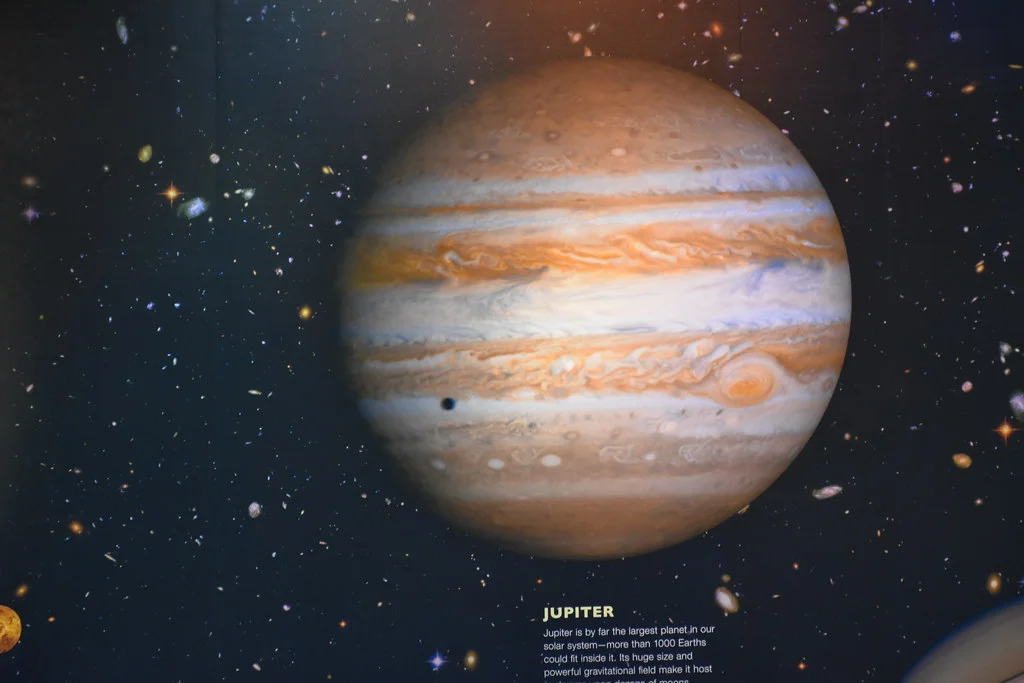Jupiter, the fifth planet from the Sun, isn’t just the largest world in our solar system—it’s a cosmic marvel full of extremes, mysteries, and fascinating science. This guide breaks down its nature, exploration missions, internal wonders, moons, and what the future holds, all through six well-defined H2 sections—designed for both Google ranking potential and reader engagement.
1. Jupiter at a Glance: Size, Composition, and Orbit
Jupiter dwarfs all other planets—in fact, it could hold about 1,000 Earths inside its volume. Composed mostly of hydrogen and helium, it resembles a failed star more than a terrestrial one.
- Fastest day in the solar system: Jupiter completes one rotation in just 9.9 hours, leading to a noticeable equatorial bulge.
- Orbit: It orbits the Sun roughly every 12 Earth years, at an average distance of 5.2 astronomical units (AU).
This massive presence shaped the early solar system, influencing planet formation through its gravitational pull.
2. The Stormy Face: Atmosphere, Weather, and the Great Red Spot
Jupiter’s dynamic atmosphere features:
- Distinct bands of belts and zones that circle the planet, driven by powerful jet streams and super-rotation.
- The legendary Great Red Spot, a storm larger than Earth that’s raged for centuries.
- Layers of ammonia, ammonium hydrosulfide, and water clouds, with convection-driven vortices, lightning, and intense turbulence.
These features not only define Jupiter’s appearance but also offer insight into atmospheric physics on a planetary scale.
3. Invisible Armor: Jupiter’s Magnetic Field and Rings
Though often called a gas giant, Jupiter packs a cosmic armor:
Its magnetosphere is the largest continuous structure after the heliosphere—stretching up to 7 million km toward the Sun and nearly reaching Saturn’s orbit in the opposite direction.
This magnetic dominance creates spectacular auroras and channels plasma, primarily from volcanic activity on its moon Io.
Jupiter also has a faint ring system, composed mainly of dust, visible primarily with advanced instruments.
Together, these structures define a powerful cosmic environment around the planet.
4. A Full-Fledged System: Moons and Exploration Missions
Jupiter rules a kingdom of moons:
- With at least 97 known moons, its most famous are the Galilean moons—Io, Europa, Ganymede, and Callisto—discovered by Galileo.
- Ganymede, the largest moon, even eclipses Mercury in size.
Exploration has only just begun:
Juno, in orbit since 2016, provides extreme close-ups of polar cyclones, atmospheric heat maps, and even volcanic hotspots on Io. Europa Clipper is on the way, set to arrive by 2030 to investigate the icy ocean below Europa’s crust. Europe’s JUICE mission aims for Jupiter’s icy moons, utilizing complex gravity assists and expected to arrive around 2031. Future missions like Io Volcano Observer (IVO) and China’s Tianwen-4 are nuclear options for probing Jupiter’s enigmatic systems.
5. Deep Inside Jupiter: Core, Interior, and Mysteries
Juno’s data has challenged old theories about Jupiter’s internal structure: Jupiter might have a diluted core, with heavier elements spread out over half its radius—perhaps the result of a massive impact early in its history. Observations show uneven ammonia distribution, which may be influenced by subsurface convection, storms, and complex “mushball” dynamics. Insights into Jupiter’s interior also help pose questions about how it formed—was its core compromised by collisions, and do composition gradients persist even today? These findings make Jupiter a living laboratory for planetary formation theories.
6. What’s Next: Future Discoveries and Jupiter’s Role in Science
Recent Advances:
Juno has detected auroral footprints tied to its largest moons. James Webb Space Telescope added new perspective on Jupiter’s auroras in 2025.
Why Jupiter Matters:
It remains a key to solar system origins—matching the early mass and conditions of planets at their formation. Studying Jupiter helps us interpret gas giants around other stars and understand planetary systems beyond our own. Upcoming missions—Europa Clipper, JUICE, and others—could uncover habitability clues, especially in subsurface oceans
Conclusion
Jupiter, the giant among planets, is far more than just a celestial spectacle visible in our night sky. From its rapid rotation and turbulent storms to its sprawling magnetosphere, mysterious interior, and world-class moons, Jupiter continues to reshape our understanding of planetary science.
Thanks to missions like Juno, Europa Clipper, and JUICE, we are entering a golden era of Jupiter exploration. Expect groundbreaking discoveries in the coming decade—on everything from volcanoes and auroras, to diluted cores and hidden oceans.





